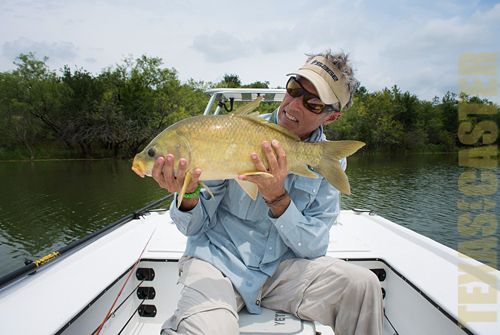Where the Buffalo Roam
buffalo smallmouth on fly

I’ll be honest, I know a rarity for a fisherman, and tell you; I don’t really know how the buffalo smallmouth got its name. And with the huge compression of my hourly time starting now, I am going to leave that answer for you to find and report to us here.
What I do know about the great slime buffalo is that their numbers, since I have been aware of them roaming, have grown to extraordinary proportions on Lake Ray Roberts, Texas. And after a foray to Lake Bridgeport yesterday, I can say their numbers there are almost as fantastic as they are in Ray Roberts.
BRIDGEPORT
I launched from the public County Park up close to Chico yesterday afternoon, and never started the motor before hitting this Bridgeport Lake TPWD fly record yesterday – just around the corner from the launch. I was hopeful on seeing the numerous mud clouds that this big guy was actually a common carp (a better eater) than a buffalo, but once I had a visual … it was actually a big letdown.
YOU SEE catching a buffalo is a matter of making lightning strike at the point of your fly. First, the fly has to show up at the right depth – dead bottom. Then the fly has to be palatable to the buffalo. Then the buffalo, buffalo smallmouth technically, has to HOOVER your fly. The odds are stacked against you. The wrong depth, too garish a fly, movement, lining the fish, mood — one of these typically steps in to divert the lightning strike. Okay, really they don’t strike light lightning, but you understand what I mean. I am always as surprised as they are when I actually hook a buffalo, it’s that rare.
MAKE NO MISTAKE though, buffalo do have a small window where they do actually “feed” like a fish. I hit that window more than once, and most memorable was a catch of a double-digit buffalo at the release area below Texoma’s Denison Dam – right up against the dam on the Oklahoma side several years back. I wasn’t dealing anything a buffalo would want, but this buffalo was definitely on the feed. I am under the impression they feed around the reproductive cycle for about a week, and if you hit that, you can actually fish for buffalo. That happened to a client last year, and he made lightning strike two times in an afternoon.
TALKING CLIENTS DOWN
For the most part, with the fantastic view from the casting deck, I have to talk clients OUT OF trying to cast for the great buffalo. The time it takes, and the likelihood of a take are so remote, that I encourage us to move on from buffalo hunting to our real objective – common carp. But, if I am out on my own, with no clock watching, I will put some effort into seeing if there’s anything a buffalo will eat.
Buffalo seem uniquely keen in the bottom-feeding fish world. They have these google-eyes that bulge out enough for them to have extraordinary vision. They are constructed in a more vertical fashion with tall flat sides, than the rounder common carp, and have much more of an “arrow look” with a fork tail and a dorsal that seems more trimmed for speed than fluttered for long pauses of hovering and eating.
Those characteristics lead to a fish that often leaves a long trail of a mud cloud and frequent changes in direction. I can’t tell you how many times I have cast at them only to have them change direction while the fly is still on the sink. I’ve never seen them tailing, and until yesterday I had never seen one with a back out of the water. I believe habitat has a lot to do with that.
Another characteristic that sets the buffalo apart is its indifference. This fish does not scare very easily in comparison to common carp. That just ADDS TO the frustration of casting at them, and although you may heighten their awareness, I often times scare them off intentionally – so I don’t have to look at them anymore!
Most of these characteristics play to the strength of the buffalo. Their only weakness is their extraordinary size. It makes them extremely easy targets for the bow fish killers, and that size is what keeps my clients and friends stepping up to the challenge of catching lightning. By the way, those physical characteristics do make for a great fighting fish.
So how can you catch a great buffalo? The first trick is to find them, and know exactly what you’re looking at when you see them. In the water, they appear darker and have distinctive movements. The TAIL IS THE TELL though. The shape of a buffalo’s tail is so different from a common carp that you will quickly learn to spot them if you concentrate on that one characteristic alone.
After that, you just pound them until one of you gives up. Sorry, but that’s the fly fisherman’s honest truth …

You must be logged in to post a comment.